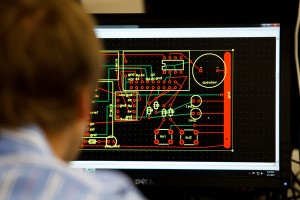From race cars to robots to underwater vehicles, St. Thomas engineering students will showcase their work at the 2011 Senior Design Clinic from 2:30 to 5 p.m. Friday, May 6, in Owens Science Hall atrium on the St. Paul campus (map and directions).
The public is invited to this trade show-style event. Attendees can learn how the students solved some tough engineering problems. The 62 seniors worked on 13 projects for 10 industry- and nonprofit-sponsored initiatives.
Here’s a sampling of their efforts:

Student Jeff Buchholz works on a portion his group's solar-wind hybrid power system.
Scott Adkins, Jeffrey Bucholz, Kelsey Hofmeister, Joe Maniaci, Kris Meyer and Linda Lininahazwe designed a solar-wind hybrid power system for Windstrip LLC. The system is designed to power cell phone towers.
Faisal Aldhafeeri, Andrew Kanne, Christopher Victor and Joseph Waidelich created a prototype for a graphics applicator for 3M. The applicator will be used to install large-scale commercial graphics onto various textured surfaces.
Rasheed Abdulkader, Jason Berger, Angela McGehee and Dan Rodemann designed a fall detection device for Courage Center to be used on elderly and rehabilitative patients living alone. The device sends an alert message to a caregiver if a patient has fallen.

Student Dan Rodemann looks at a schematic of the fall detection device his group designed for Courage Center.
Ahmed Abuabdullah, Kyle Biddle, Christopher Cogan, Anna Garin and Elizabeth Langer worked on an electrolysis water purification device for Compatible Technology International. The device will be used to eliminate common pathogens from water sources found in developing countries.
Kirk Baglien, Kirsten Halstead, Alan Intveld and Joe Murphy designed a steam quality monitoring system for Emerson. The low-cost, in-line device will monitor steam quality in the process heating, electricity generation and liquid tank heating fields.
Michael Cowdrey, Hans Pflaumer, William Besser, James Moorman and Sven Hendrickson built a Formula SAE open-wheeled race vehicle frame with a 50 percent increase in torsional stiffness and no increase in frame weight over a previously designed model.
Mohammed Al-Mohsin, Jeremy Berghoff, Erik Eaton and Brian Jensen worked on a magnetic drive transmission for Future Force, LLC. They were tasked with designing three different gearboxes for the transmission with 2:1, 5:1, and 15:1 ratios.

Students Anna Garin, Ahmed Abuabdullah, Kyle Biddle, Chris Cogan and Beth Langer with their water purification device.
Josh Jeske, Kyle Mader, Craig Martin and Matt Moore designed a precision plenum monitor for laser cutting for LasX Industries, Inc. The monitor was designed to be used with LasX’s guided laser technology.
Ryan Huynh, Nicholas Pooler, Hans Rieckmann and Dan Schupp designed a static electricity jacket for power generation for Lockheed Martin. The jacket is designed to capture static charge, then store and regulate it for practical applications
Matthew Deutsch, Sean Engen, Jim Giancola, Josh Kleven, Frances Van Sloun and J.B. Korte designed a persistent gliding waterframe in collaboration with the University of Beira Interior – Portugal. The waterframe is an autonomous underwater vehicle that will serve as a sensor platform to quantify and monitor the oceans’ ability to produce sources of protein destined for human consumption.
Alex Benson, Ryan McCarthy, Michael St. Dennis, Adam Truhler and Matthew Maurer designed a multi-linkage mechanical creature. The creature is a robot that uses multi-linkage legged locomotion to achieve an animal-like walking movement as an alternative to rolling motion.
Ying Yang, Derek Olson, Shane Norman, Nate McNamara and Austin Wittrock designed a pipe lining system for 3M. The system they created applies a rapid setting polyurea lining within pipe ranging from six to 24 inches in diameter.
Benton Garske, Daniel Lucey, Brian Osende, Nathan Uecker and Chad Weigelt worked on a wind tunnel test section for fluid dynamics demonstration for Emerson. The device the students created supplements the new St. Thomas engineering course on fluid dynamics.







